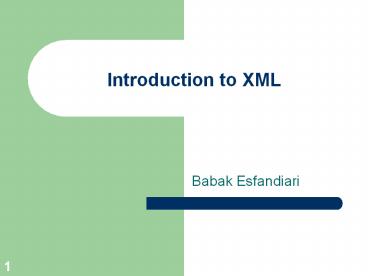Introduction to XML - PowerPoint PPT Presentation
Title:
Introduction to XML
Description:
DOM. creates a tree structure of objects. stores it in memory ... DOM. use it if you need 'random access' to various elements of the document ... – PowerPoint PPT presentation
Number of Views:19
Avg rating:3.0/5.0
Title: Introduction to XML
1
Introduction to XML
- Babak Esfandiari
2
What is XML?
- introduced by W3C in 98
- Stands for eXtensible Markup Language
- it is more general than HTML, but simpler than
SGML - it is used to to describe metadata
- you can define your own set of tags!
- an XML document does not do anything on its own
3
XML example
- lt?xml version"1.0" ?gt
- lt!-- a simple tagset for museumsgt
- ltMuseum name"Louvre"gt
- ltcitygt Paris
- lt/citygt
- lt/Museumgt
4
XML - what for?
- content is independent from rendering
- meta-data makes search easier
- standard tags enable data interchange across
tools - format for data and object persistence, human
readable and editable - no need for a custom parser anymore
5
XML concepts and syntax
- Elements
- can be nested
- must have a closing tag
- Attributes
- XML declaration
- Comments
6
XML concepts (2)
- An XML document that follows the syntax rules is
considered well-formed - But there is no restriction on the nature, order
and number of tags in a well-formed XML document! - in order to impose some restrictions, you need to
define validity criteria in a separate document
7
DTD
- Document Type Definition
- Describes the XML tagset
- lt!DOCTYPE Museum
- lt!ELEMENT Museum (city?)gt
- lt!ATTLIST Museum name CDATA REQUIREDgt
- lt!ELEMENT city (PCDATA)gt
- gt
- An XML document that is compliant to its DTD is
valid
8
DTD Syntax
- Defining elements
- lt!ELEMENT Museum (city?, genre)
- Character data types
- PCDATA (is parsed)
- CDATA (is not parsed)
9
DTD
- DTDs are hard to read
- DTD has its own syntax
- DTD has very limited support for data types
10
XML Schema
- a 2001 W3C recommendation
- allows the definition of elements and attributes
using the XML syntax - supports many primitive types
- allows the creation of complex types
- uses namespaces to
- allow reuse of types and schemas
- avoid naming clashes
11
XML Schema Example
- http//chat.carleton.ca/narthorn/project/communit
y.xsd
12
Some XML-based standards
- MathML
- CML
- MusicXML
- XMI
13
XMI Example
- ltClassgt
- ltnamegtMuseumlt/namegt
- ltfeaturegt
- ltAttributegt
- ltnamegtnamelt/namegt
- lt/Attributegt
- lt/featuregt
- lt/Classgt
14
XML Parsing
- Many XML parsers are available JAXP, XERCES
- Two standardized parsing methods
- SAX
- event-driven
- serial-access
- element-by-element processing
- DOM
- creates a tree structure of objects
- stores it in memory
- easier to navigate, but more memory needed
15
SAX
- good to use if you are consuming XML data from
a stream - see Echo.java example (from JAXP)
16
DOM
- use it if you need random access to various
elements of the document - see EchoDom.java example
17
XSLT
- eXtensible Stylesheet Language Templates
- allows the transformation of one XML document
into another by specifying transformation rules
18
XSLT example
- ltxslstylesheetgt
- ltxsltemplate match"Class"gt
- blah ltxslvalue-of select"name"/gt blah
- ltxslapply-templates select"feature/Attribute"/gt
- lt/xsltemplategt
- ltxsltemplate match"feature/Attribute"gt
- ltxslvalue-of select"name"/gt
- lt/xsltemplategt
- lt/xslstylesheetgt
19
Semantic Web
- Tim Berners-Lees idea of the future of the Web
- The goal is to make information accessible to
non-humans(ie agents) - Therefore information should be structured and
use metadata - RDF is proposed as such structure
20
RDF Example
- See Software Agents course example
21
Refs
- W3C specs http//www.w3.org/TR/REC-xml































